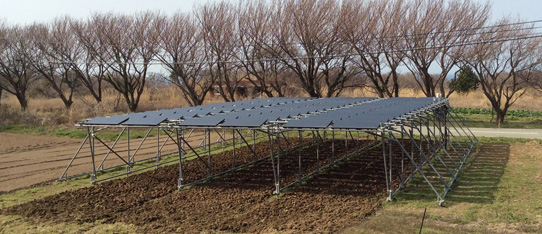- News
14 June 2016
University of Tokyo tests 'solar sharing' using Solar Frontier's CIS solar panels above farm crops
Tokyo-based Solar Frontier – the largest manufacturer of CIS (copper indium selenium) thin-film photovoltaic (PV) solar modules – has provided its CIS solar panels for a 'solar sharing' experiment on Sado Island, Niigata Prefecture, Japan.
Solar sharing in Japan refers to the practice of using the same plot of land to simultaneously grow crops and generate solar power. Panels are installed high above the crops and spaced further apart than usual, enabling sufficient sunlight to pass through and farmers to work below. This business model has been gradually spreading across Japan, helping farmers to earn additional income by selling electricity.
Advancing this experiment is the University of Tokyo's IR3S (Integrated Research System for Sustainability Science), which aims to evaluate the potential economic impact of solar sharing on Sado Island, where the population is both declining and ageing. It is doing so as part of a broader project, which looks at using renewable energy and maximizing natural resources to achieve a low-carbon society and help to revitalize communities.
Solar Frontier has provided 10kW of its lightweight Solacis neo CIS solar panels for this experiment. In real-world conditions, CIS solar panels yield more electricity than crystalline silicon panels, including areas that receive lower levels of sunlight such as Sado Island, says the firm. This is currently being demonstrated by installations such as the Niigata Yukiguni Megasolar Power Plant (connected in 2010 in Niigata Prefecture) as well as smaller projects such as Gakko Gura ('school cellar'), a Japanese sake brewery that re-uses the building of a former elementary school on Sado Island.

Picture: Solar Frontier's CIS solar panels installed over a small field of newly planted broccoli.
Solar Frontier's panels have been installed facing south at a low inclination angle of 13.5°, and are expected to generate about 11,000kWh per year. The panels have also been installed 2m high, enabling the farmer to tend to his crop. In this particular case, it has started with a round of broccoli which will be followed by a range of seasonal vegetables as the year progresses. The test will hence provide data on light-shielding rates and crop yield for the Washizaki district (an area with relatively difficult farming conditions).
Solar Frontier says that it will continue to focus on collaborating with industry, academia and government, utilizing its CIS thin-film modules to promote distributed energy generation initiatives rooted in local regions.
Solar Frontier CIS thin-film PV modules


